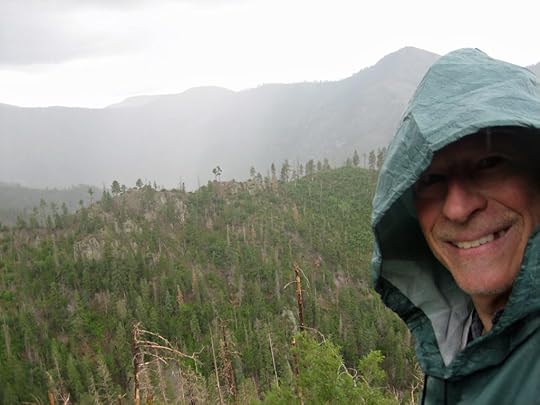Wet Enough?

What is it about this year? First, the summer solstice fell on my hiking day. And now, the 4th of July, the day Americans celebrate the violent founding of their colonial state by blowing things up.
There was no way I could get away from my fellow Americans on this day, they’d be swarming all over the backcountry – except for our wilderness area, which was still closed, despite the big wildfire having been snuffed out by monsoon rains. Almost all of my favorite hiking areas had been off limits for over a month now, and I was getting desperate.
One trail remained open, far to the north, another two hour drive from home. It traversed some of the worst burn scars from the 2012 wildfire, near the crest of the mountains, gradually descending into the headwaters of the longest and most dramatic canyon in the range. The Forest Service listed this trail as “cleared”, but I’d tried it a couple years ago and found it badly eroded and blocked by some nasty deadfall.
However, since then I’d hiked much worse trails, so maybe I should give this one another chance. In general, I prefer peak hikes rather than canyon descents, but the climb back out of this canyon didn’t look too bad on the topo map.
We’d had a week of cool days with light rain – typical monsoon weather, but a little too early. The old timers say “rain in June, poor monsoon”. Sunday was forecast to be warmer and drier, and most of this hike would be exposed on a south-facing slope, so I packed ice in my drinking water reservoir again.
However, when I finally reached the mountains, the air was cool and storm clouds were forming. The access road passes through the little ghost town, and then becomes a very rough, steep dirt track that twists through dense forest and climbs 2,000′ in a few miles. After the first mile or so I was surprised to pass a young woman dressed in a stylish fitness suit, hiking up the road alone, carrying a tiny day pack.
At the trailhead I found three young guys, probably college students, camping and having a party. They’d gotten there in a tiny, 20-year-old Nissan sedan – I’m often amazed by the vehicles people bring on these backcountry roads.
The hike starts with a super-steep climb through dark fir and aspen forest to the top of a ridge at 9,000′, followed by a long traverse across moonscape burn scar, dipping into remnants of intact forest here and there. The first mile and a half turned out to be easier than I expected.
A dark mass of clouds had been forming straight ahead, over the highest part of the range, accompanied by the rumble of distant thunder. When the rain began it was light, and I didn’t pay it much attention because the hike was getting harder – the farther I went, the more deadfall and the more thorny New Mexico locust filling in the burn scars and choking the trail.
But suddenly rain began falling harder, and I had to stop and pull on my waterproof poncho.
Now I was hiking in a downpour, and everything got much harder. The deadfall logs were slippery and the footing underneath – loose dirt and sharp rocks – more treacherous. I had to slow down and use a lot more caution. The trail came to a deep gully containing intact forest, descending hundreds of feet at between 30 and 40 percent grade, then climbing up the other side. I suddenly realized my boots were filling with water – I could feel it sloshing back and forth. They’re made of leather and GoreTex and should be water-resistant – how was the water getting in?
I tried to speed up, but the trail was getting much worse the farther I went, and the storm was really dumping. Locust thorns started tearing my poncho apart, so I tried to stomp them as I walked, but they were just too thick.
These monsoon storms usually only last 20 minutes or so. I was hoping this one would end soon, and I could stop in the canyon bottom, drain the water out of my boots, and put on the spare socks I carry in my pack. They would get wet, but they were wool so they’d still keep my feet warm.
The rain did eventually fade, but shortly afterward, I reached a point where the trail just disappeared into a jungle of thorns and deadfall. If I’d been dry, I might’ve tried to penetrate it, but with my poncho torn up and my feet sloshing in water I was frankly miserable. And my last view of the canyon had shown it to still be hundreds of feet below me. I wasn’t anywhere near my planned destination.
I stopped there in the jungle, used a deadfall log as a bench, and spread out the damaged poncho on the ground underneath. All my clothing was soaked. The only thing I had that was dry was the spare socks and three bandannas in my pack. I took off my wet socks and used two bandannas to dry my feet and sop as much water out of the boots as possible, then put on the dry socks, and had lunch.
I’d really been looking forward to reaching the canyon bottom – there’s supposed to be a nice meadow there where backpackers camp. This spot in the jungle was ugly and I hated to just turn back, but I really had no choice.
As I headed back up the trail, storm clouds were parting, opening up patches of blue sky, and re-forming in the distance to the west. I could see a veil of rain hanging over the mouth of the canyon, a dozen miles away. I knew I should be grateful we were having this rain, but I was just bummed about going home early from another failed hike.
While I was returning up the trail, and watching the weather developing to the west, another mass of clouds was forming behind me. For some reason, I’d assumed I wouldn’t have any more rain today, but I was wrong. Just as I began crossing the deep gully with intact forest, drops began to fall, and as I climbed the steep slope out the other side, the rain fell heavy on me again. I pulled the wet, torn poncho out of my pack and pulled it back over me and my pack. By the time I topped out of that gully, my feet were soaking wet again, and I still had a couple miles to go. I was not a happy hiker.
Between climbing over logs and pushing through locust thorns, I gazed down at my boots, and suddenly realized that the GoreTex on the “tongue” of the boot simply wasn’t working. When the boots are laced, the base of the GoreTex tongue forms a little hollow, and rainwater was funneling into it and directly through the layer of GoreTex straight onto my toes. So much for “water-resistant” GoreTex.
There was nothing to be done about it, so I just kept picking my way carefully through the maze of thorns and deadfall. Lightning was striking all around me, every few minutes, followed by cracking, rolling thunder. And there I was in the midst of a burn scar, totally exposed, high up in the sky.
Eventually I crested the ridge and began descending through the dark forest, back to my truck. The rain faded to a drizzle.
The partying campers had left, but as I approached my truck, a late-model minivan came careening down the steep, rocky road, where it encountered a convoy of three big pickup trucks heading up. The first of the pickups stopped beside my truck, and the passenger window rolled down. There were two teenage guys inside, and the driver said something – I could only make out the word “truck”, so I stepped around my vehicle and said, “What’d you say?”
He spoke again, but so quietly it seemed he must be speaking to his companion instead of me. I walked up to their window and repeated “I can’t hear you.”
The driver looked embarrassed. “Sorry, we’re looking for somebody.” He smiled and drove off, the other vehicles following.
I loosened my boots – everything I was wearing was wet, I didn’t have any more dry clothes with me, and I would just have to drive home that way – all two hours of it, including the scary one-lane road from the ghost town.
Fortunately I didn’t encounter anyone on the one-lane road, but I did pass through some apocalyptic rain on the highway – twice. It rained so hard the road was flooded and I had to slow to avoid hydroplaning. Wet as I was, I felt lucky to get home safe.



